- After six days spent lodged in the Suez Canal, the Ever Given container ship has finally been freed by Egyptian workers
- The 400-metre-long Ever Given became wedged in the canal on Tuesday, causing delays for more than 300 other ships
- It’s estimated the blockade of the major trade route cost shipping companies around $US14 million per day (around A$18.3 million)
- Hundreds of other cargo ships had been stuck behind the vessel or were forced to divert away from the canal which connects Asia and Europe
- Authorities unsuccessfully used recent high tides to try and free the Ever Given, but the failure has prompted calls for the vessel to be stripped of its cargo
After six days spent lodged in the Suez Canal, the Ever Given container ship has finally been freed by Egyptian workers.
Additional tugboats were brought in over the weekend to try and dislodge the 400-metre long vessel that had been blocking the key trade route.
The Japanese-owned Ever Given became wedged in the canal on Tuesday morning, causing delays for more than 300 other ships waiting to pass through.
Rescue efforts
Egyptian authorities attempted to free the blocked vessel by carrying out dredging at one of the walls where the ship has hit land.
Tugboats were also been sent in to try and move the vessel away from the walls in an attempt to refloat it.
However, the rescue efforts had been complicated by the fact the ship’s bow was sitting on rocks, causing a hole in the hull.
Authorities had also planned to take advantage of recent high tides and use the excavators and tugboats to try and dislodge the Ever Given, but their efforts failed.
Following the two unsuccessful attempts at the weekend, the Egyptian President ordered that the damaged vessel have its cargo removed as a contingency plan.
Knock on effects
The Suez Canal Authority said every day the blockage continued, it cost an estimated $US14 million (around A$18.3 million).
The Suez Canal is one of the world’s busiest trade routes and one of the few shipping links connecting Asia and Europe.
Hundreds of other cargo ships, containing everything from crude oil to livestock, had been stuck behind the blocked vessel.
Additionally, dozens of other vessels were forced to divert away from the canal and go down the African coast, past the Cape of Good Hope and back up towards Egypt.

